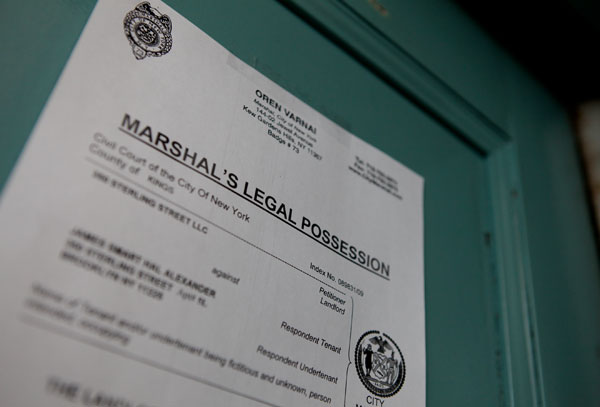
Photo by: Marc Fader
A marshal’s eviction notice, seen in 2010
The Bronx Housing Court is in desperate need of reform. Close to two thousand Bronx tenants are brought to the Bronx Housing Court every day by their landlords. In 2012, 11,000 families were evicted—their lives were uprooted as their children changed schools, their jobs were put at risk and hard-earned belongings were lost. Evicted tenants are future shelter residents: 44 percent go into the city’s overburdened shelter system.
To determine what is happening in the Housing Court and why there are so many evictions, New Settlement Apartments’ Community Action for Safe Apartments (CASA) launched a research project in partnership with the Community Development Project (CDP) at the Urban Justice Center, collecting 1,055 surveys, conducting 15 judge observations and holding three focus groups with 25 participants.
The results of the research are powerful. An overwhelming number of tenants aren’t provided with basic information and resources to navigate a confusing court system. Almost all tenants lack legal representation, which gravely affects cases, especially since half of all stipulations are signed in unmonitored hallway negotiations.
Instead of speaking to judges and court officials, our data shows that more than half of all tenants are asked to pay the rent they owe in the court’s hallways, before even entering the courtroom. Eighty-five percent didn’t know they had the right to object to legal fees and 53 percent said that no one explained their options if the landlord didn’t make repairs as promised.
There are plenty of hurdles for tenants in the Bronx Housing Court. Basic rules and procedures aren’t explained, most judges don’t fully explain stipulations, court employees aren’t easily identifiable and there aren’t enough informational brochures and signs, to name a few.
As a result of these flawed court practices, tenants are being evicted because they don’t understand what they are signing, because they agree to sign a document against their interest out of fear or because they are denied the right to counsel to defend their homes and their livelihoods. Tenants are being evicted at a staggering rate because the court is failing to do its job.
So, what can the state do to improve the Bronx Housing court?
Studies show that diverting resources from the shelter system into legal representation for tenants would both decrease eviction rates (by more than 30 percent) and increase savings by $67 million. Governor Cuomo and Judge Lippman should take a hard look at this report and choose to invest resources into the city’s Housing Court system.
This is just one of the many recommendations that are included in the recent report “Tipping the Scales: A Report of Tenant Experiences in Bronx Housing Court” for elected officials and court officials to consider.
Forty years after housing court opened its doors, we are at a critical moment. It is time for the state to act.








